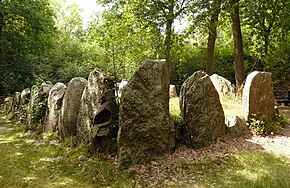Sieben Steinhäuser

Grave D, the largest of the five gravesites
|
|
| Location | Bergen-Hohne Training Area, Lower Saxony, Germany |
|---|---|
| Region | Germany |
| Coordinates | 52°48′00″N 9°47′51″E / 52.800°N 9.7975°E |
| Type | Dolmens |
| History | |
| Periods | Neolithic |
| Cultures | Funnelbeaker culture |
| Site notes | |
| Public access | Yes (limited) |
The Sieben Steinhäuser is a group of five dolmens on the Lüneburg Heath in the NATO training area of Bergen-Hohne, in the state of Lower Saxony in northern Germany. The stones are considered to be part of the funnelbeaker culture (3500 - 2800 B.C.). The gravesite was granted protected cultural monument status in 1923.
The Sieben Steinhäuser are located roughly in the middle of the Bergen-Hohne Training Area which lies between Bad Fallingbostel to the northwest and Bergen to the east.
The dolmens are found at a height of 56 and 67 m above sea level (NN). A stream, the Hohe Bach ("High Brook") which is a northeastern tributary of the River Meiße in the catchment area of the Aller, flows past the stones in a north-south direction.
The only public access route to the dolmens begins at a barrier in Ostenholz, about 4 kilometres (2.5 mi) southeast of the Walsrode autobahn interchange. The access road runs for several kilometres through the out-of-bounds area of the military training area. It is regularly cleared of any spent ammunition from the ranges. The site is only accessible on days when no exercises are taking place i.e. at weekends and on public holidays between 8 am and 6 pm.
The Sieben Steinhäuser gravesite was established during the third millennium BC during the neolithic funnelbeaker period by the first settled farmers. The large gravesite, Grave D, shows similarities to French gravesites, the other four are like those of the Elbe-Weser Triangle.
...
Wikipedia

